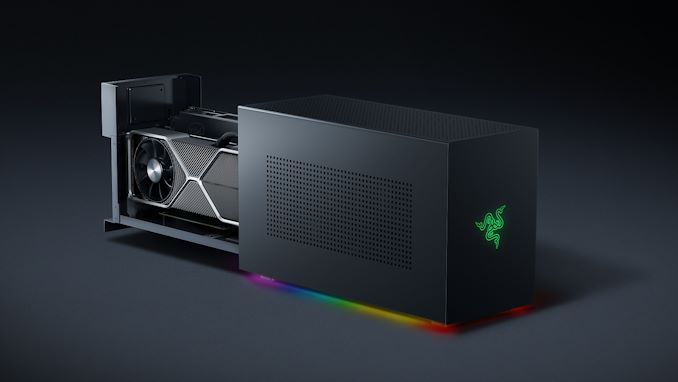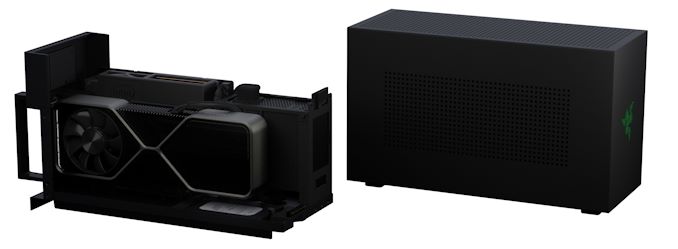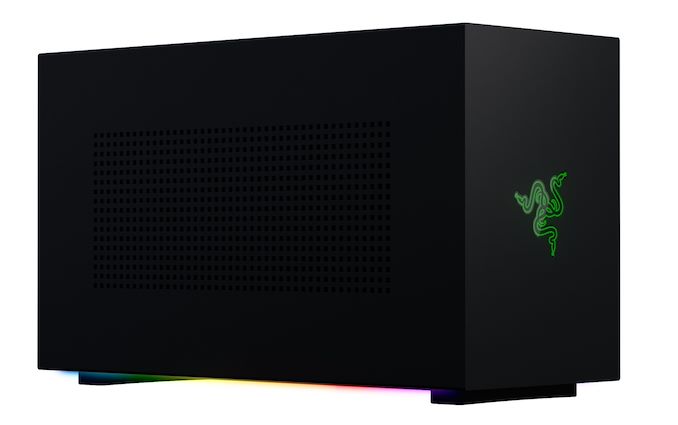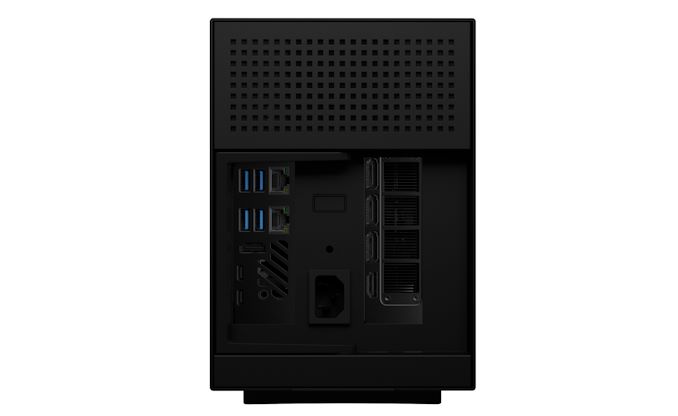Razer's First Modular PC, The Tomahawk: A Fully Custom NUC 9 Extreme
by Gavin Bonshor on December 3, 2020 10:00 PM EST
Razer, a company that styles itself as 'by gamers, for gamers', has today unveiled its latest product, a modular NUC dubbed the Tomahawk. Available as both a barebones package and a high-tier gaming solution, the Razer Tomahawk looks to offer a 'cutting edge' mixture of functionality, performance, and graphics card compatibility, all within a NUC inspired chassis. Some of the key specifications include an Intel 9th generation Core i9 processor, with a 512 GB PCIe 3.0 x4 SSD, 2 TB of HDD storage, 16 GB of DDR4-2667 memory, and an optional RTX 3080.
The term NUC (Next Unit of Computing) gets thrown around a lot when it comes to super small form factor desktop computers, even when NUC is technically an Intel term. Going all the way back to 2014, when Razer's CEO unveiled a conceptual design for a modular PC dubbed 'Project Christine,' Intel looked to have taken the idea a step forward with what it called Element. We've seen many Intel NUCs hit the market this year, including the NUC 9 Extreme (NUC9i9QNX), which we reviewed back in April. Razer being Razer has gone one step further on this idea and created its own version of the NUC, with the Razer Tomahawk.
What sets the Razer Tomahawk apart from other NUCs on the market is its full-scale capability to install a full-sized graphics card with a maximum length of up to 320 mm, with a maximum height of 140 mm. This moves away from common small form factor systems, which generally have to opt for smaller alternatives such as the NVIDIA GTX 1650. The Razer Tomahawk features a tool-less sled that allows users access to the system, which could be to upgrade the storage or even install a new graphics card.
While this is a 'modular' system, it is essentially a PCIe backplane with two PCIe slots. In one slot goes the graphics card, and in the other is 'the rest of the PC'. That rest of the PC includes a 45 W overclockable mobile processor (unupgradable), memory (upgradeable), and storage (upgradeable). Despite there being a barebones option, Razer pre-populates all models with a 512 GB NVMe SSD, a 2 TB HDD, and 16 GB of DDR4-2667 (Razer doesn't say if this is 1x16 or 2x8). On both models there is a spare M.2 NVMe slot, and the barebones simply lacks the discrete GPU, but the integrated GPU can be used if there is not a discrete GPU present.
It wouldn't be a Razer product if it didn't have RGB LEDs. It includes an illuminated green Razer logo on the front panel, with addressable RGB LEDs on the underneath of the chassis to provide a bit of flair. Focusing on the size, the Tomahawk chassis is 19.23 x 24.15 x 1.60 inches (HxWxD), so it is svelte, and it also weighs in at 16.2 lbs. In terms of volume, the chassis itself is 10 L, which is big enough to fit all of the components in when designed efficiently.
| Razer Tomahawk Gaming NUC Desktop | ||
| Component | Barebones | Full System |
| CPU | Intel Core i9-9980HK (Coffee Lake) 8 Core / 16 Thread 2.4 GHz Base 5.0 GHz Turbo 45 W TDP |
|
| GPU | Optional (Intel UHD 630 if none) |
NVIDIA RTX 3080 Founders Edition 1.71 GHz Boost 10 GB GDDR6X |
| Memory | 16 GB DDR4-2667 | |
| Storage | 512 GB NVMe PCIe 3.0 x4 2 TB 5400 RPM Hard Drive 1 x M.2 PCIe 3.0 x4 (open) |
|
| Networking | 2 x Gigabit LAN | |
| Wireless | Intel AX200 (Wi-Fi 6/BT 5.0) | |
| I/O | 2 x USB 3.2 G2 Type-C (Thunderbolt 3) 4 x USB 3.2 G2 Type-A 1 x 3.5 mm audio jack 2 x Gigabit RJ45 1 x HDMI 2.0a |
|
| Audio | 3.5 mm TOSLINK combo port | |
| Power | 750 W SFX Power Supply | |
| Dimensions | 19.23 x 24.15 x 1.60 inches (HxWxD) | |
| Weight | 16.2 lb/7.35 kg | 18.3 lb/8.3 kg |
| Pricing | $2400 | $3200 |
| Availability | ??? | |
Given the nature of the hardware installed, Razer has opted to cool the processor actively and includes two top-mounted 120 mm chassis fans, with ventilation on both side panels and the top panel. Powering the Tomahawk is a preinstalled 750W SFX power supply, although Razer hasn't specified the exact model.
In terms of connectivity, the Tomahawk includes four USB 3.2 G2 Type-A ports, with two Thunderbolt 3 USB Type-C ports, and a single HDMI 2.0a video output. Users opting for the full package, including an NVIDIA RTX 3080 Founders Edition graphics card, adds three DisplayPort 1.4b and a single HDMI 2.1 video output. Networking includes two Gigabit Ethernet ports driven by unspecified controllers, while there's also an Intel AX200 Wi-Fi 6 interface, which includes support for BT 5.0 devices. Nestled in between the motherboard and graphics, I/O is a single 3.5mm audio jack that can accommodate speakers or act as a TOSLINK combo port.
A few possible use case scenarios for those with bottomless pockets or shallow desks could find this an ideal system to take to LAN, to and from work, or even for an on the go content creator. While Razer did unveil its own chassis called the Tomahawk Elite back at CES 2019, the Tomahawk Gaming System is a higher-grade and RGB infused version of Intel's NUC 9 Extreme.
As previously mentioned, the Razer Tomahawk gaming desktop will be available as barebones without a graphics card for a base price of $2400, while the full model equipped with an RTX 3080 Founders Edition will cost $3200. It's not a cheap outlay, especially for an Intel system featuring an RTX 3080, but the latter hasn't been easy to source of late.
Related Reading
- ASRock Brings Zen 2 NUC: 4X4 BOX-4800U Renoir Mini-PC Reviewed
- Intel Ghost Canyon NUC9i9QNX Review: NUC 9 Extreme Realizes the SFF Dream
- Kontron Releases KBox B-202 CFL Mini-ITX PC: SFF Desktop For Commercial Use
- CES 2020: ZOTAC's Inspire Studio SFF PCs for Creators w / 8-Core CPU and GeForce RTX
- Razer's Project Christine: A Modular PC Prototype





_thumb.jpg)
_575px_thumb.jpg)
_thumb.jpg)
_575px_thumb.jpg)
_thumb.jpg)
_575px_thumb.jpg)








61 Comments
View All Comments
IGTrading - Friday, December 4, 2020 - link
I wouldn't touch any Intel-based NUC.When an AMD version launches, we'll likely be able to recommend it.
Heck, I might buy one myself, although it would be a bit overkill for me.
jtd871 - Friday, December 4, 2020 - link
Essentially DOA for enthusiasts who can roll their own. Looks like an overgrown DAN A4 or Sliger mITX case - except that the Razer can't accept standard parts and looks way larger physically based on the GPU shown for scale.Also, the dimensions listed do not match the appearance. No way this thing is 19.23 x 24.15 x 1.60 inches (HxWxD)! Please double-check and update.
Flunk - Friday, December 4, 2020 - link
When I saw the photo here I thought it was a new version of Razer's external GPU enclosure.meacupla - Friday, December 4, 2020 - link
Is there a conversion error on the product dimensions?How can this thing be only 1.6in or 40mm deep?
That's literally the thickness of a double slot video card.
mrvco - Friday, December 4, 2020 - link
I like the concept to a point, but we live in a world with a multitude of standard SFF mITX options. This thing has 'mom's credit card' written all over it.coconutboy - Friday, December 4, 2020 - link
Look at the shape of the Tomahawk, keeping in mind the vid card in particular.Dimensions: 19.23 x 24.15 x 1.60 inches (HxWxD)
Does that thing appear to be less than 2" in any direction? Nu-uh. And a 19 inch by 24 inch case ain't tiny either. Razer doesn't list dimensions on their website, but that info can't be accurate.
Didn't read all the comments, so maybe this was posted.
lorribot - Sunday, December 6, 2020 - link
It looks like they have basically dropped in an Intel NUC Compute Elements module which run to around $1900 so around $500 for the case, PSU, RAM and Storage then £800 for the graphics card.https://www.intel.co.uk/content/www/uk/en/products...
Spunjji - Monday, December 7, 2020 - link
I doubt they're paying retail price, but damn those prices are steep. No thanks, Intel.Thayios - Friday, December 18, 2020 - link
Makes sense: this is what I just did with a new Mac Mini basically (Razer Chroma Core eGPU Enclosure). Why not throw it all into a slightly bigger box? The form factor would fit perfectly under my dual person desk in our home office whereas as standard ATX has zero chance of fitting anywhere here.Thayios - Friday, December 18, 2020 - link
(Mac Mini here as I wanted Mac OS)